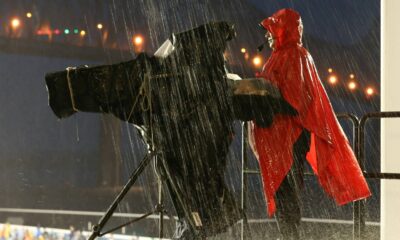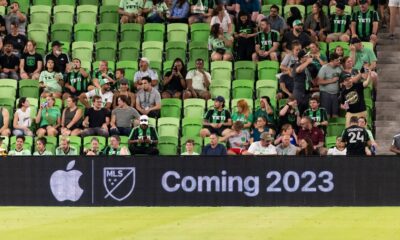In September 2014, Ian Plenderleith’s Rock ‘n’ Roll Soccer: The Short Life and Fast Times of the North American Soccer League hit bookshelves around the world.
Rock ‘n’ Roll Soccer is a portrait of the original North American Soccer League and the salad days of the professional game in the US and Canada. Throughout the book, Plenderleith recounts the tales of a league that few today will remember; and in some cases, ever have watched. From the ill-fated Team America in Washington DC to Eusebio’s four team NASL sojourn, Rock ‘n’ Roll Soccer is an extensive look at the fly-by-night league.
While other books and documentaries have been based on the New York Cosmos or Pele, Rock ‘n’ Roll Soccer takes a broader view of the league, with many of the stories told by the NASL players and coaches themselves.
This week, World Soccer Talk was able to sit down with Ian Plenderleith to talk about the NASL, soccer in the US and Canada and the years of North American soccer that are unknown to younger generations today.
Drew Farmer: Firstly, I just want to say how much I enjoyed reading your book Rock ‘n’ Roll Soccer: The Short Life and Fast Times of the North American Soccer League. How did the concept for the book come about and how connected were you to the original NASL?
Ian Plenderleith: How the book came about is simple – I wrote a few features about the league down the years, and was amazed that there had been no comprehensive book written about it. There are books about individual teams, especially the Cosmos, or by individual players who featured in the league, but nothing covering the whole league’s evolution and demise, and looking at the bigger picture of the NASL’s 17 years.
I had no connection to the NASL at all while it was actually in existence, other than knowing it as a faraway league where a lot of British players went during the summer, and that they wore garish kits, had weird names, and played on ‘plastic’ (artificial turf) pitches. The Tulsa Roughnecks actually came and played at my home town club Lincoln City in 1979 (we beat them 9-2), but I missed it completely as I was on holiday with my Mum. I bought the program off eBay, but I have no recollection of it happening at the time.
Drew Farmer: You are a resident of Washington DC, though originally from the UK. Compared to the 70s glory years of the NASL, what is your current opinion of US soccer and Major League Soccer?
Ian Plenderleith: First, I actually just moved from Washington at the start of the year, after living there for 16 years, and now I’m in Frankfurt, Germany. However, that’s given me time enough to form an opinion of US soccer.
I get asked a lot to compare MLS with European leagues. Is it the lower end of the Premier League? Is it Championship level? Is it better than the Swiss first division? I think those comparisons are not only impossible to make, but they miss the point. US soccer is a long-term work in progress, and it is making steady steps forward, with occasional setbacks. Its development is a little like the other nascent-to-rising footballing nations – Australia and Japan. They don’t have the 100-150 years of tradition and history of European and South American nations, so everything is happening at a different pace, under different social and economic circumstances. That is, their survival and progress depends on a lot of external economic factors – how they compete with sports already established in their countries, and with the major European leagues being broadcast on TV.
So you don’t have 100s of clubs springing up spontaneously, because it’s the new craze, as happened in Europe and South America (although this did happen in some areas of the US in the early 20th century too). You have people sitting down with a business plan, a stadium blueprint, and marketing surveys to see if there will be demand for semi-pro and pro soccer. By necessity, it’s quite calculated, and this has led to MLS being much more stable than the NASL, which was a kind of Wild West league in many ways.
Drew Farmer: Rock ‘n’ Roll Soccer had interviews with several of the big players of NASL era. How easy was it to compile the interviews and match information for the book? Were most players and people interviewed quite forthcoming? Was there anyone you wanted to interview that declined?
Ian Plenderleith: Well, Pele and Johan Cruyff were not available, needless to say, though I did ask politely. Many others were much more co-operative, and I am truly grateful to them – in many respects, it’s their words that make the book, and I wrote everything else around them. It was intensive work (I had a very short deadline, which I more or less imposed on myself), but hugely enjoyable. Players were generally wary until I explained what I was trying to do – give credit to a forgotten league and put it in its deserved historical context. After that they were happy to talk. Sometimes they were very vague or evasive on the rock ‘n’ roll side of things, but I was fine with that – I didn’t set out to write a ‘they-all-took-loads-of-drugs-and-had-loads-of-sex’ book. I’m sure some did, some didn’t. It was the 70s, after all. But to me, that’s not a particularly interesting aspect.
Drew Farmer: Near the end of the book, Rodney Marsh had a few quotes about the new NASL and Tampa Bay Rowdies. Ian, what are your thoughts on the revived league and can it return to something similar to the original league? Do you share Marsh’s thoughts on the league?
Ian Plenderleith: No, I don’t agree with Rodney on that one, though I can see why he denigrated it – he’s someone who’s used to top class football. That’s what he played, and that’s what he wants to see. For me, the more teams and leagues there are, the better. Personally, I’d watch anything (and I do) – I grew up watching Lincoln, Scunthorpe and Grimsby, after all.
I had a bit of a testy email exchange with the current [New York] Cosmos, though, because they objected to me referring to the new league as “semi-pro” in the book. That wasn’t intended as a putdown. In many respects, the old NASL, especially in its early years, was semi-pro too, at least according to my definition. That is, players played and were paid for less than half a year, at least until they started the winter indoor league(s). To me, semi-pro is when you have players on contracts that mean they have to work other jobs, because the break between seasons is several months long, or because the players are also coaching or working other jobs to make a living. There’s no shame in that for a brand new league in a country like the US. In that respect, many MLS players could have been classified as semi-pro until they re-negotiated the minimum wage in the latest round of pay negotiations. It’s not an insult, it’s just a reflection of a league’s status at this point in time.
Can it grow to the size of the old NASL? Again, I think that question doesn’t really apply. I think eventually it would be best if the leagues merge and we end up with two or three divisions with at least some form of relegation and promotion when that’s sustainable. The US is, after all, the ultimate meritocracy, or at least in theory. It can also be more protectionist than a Soviet planned economy.
Right now, though, MLS and NASL seem to be in an unspoken competition, and from what I can gather at this distance, they’re not on especially good speaking terms.
Drew Farmer: Similar to the last questions, do you believe MLS, like NASL, has expanded too quickly? Last season saw the league contract Chivas USA. I believe people are overestimating soccer’s popularity in the US, which is producing a saturated market of teams (Keeping in mind, I am a Yank currently living in the UK). Would you agree or disagree with that statement?
Ian Plenderleith: I’ve been surprised by the pace of recent expansion. It’s not necessarily bad from an economic point of view, because every new city has been carefully monitored by MLS for its potential as a soccer market, and the fee to found a new franchise now is quite phenomenal – $100 million, I think – so it’s not like the old NASL days when new teams were handed out willy-nilly to anyone with a down payment and a local college football stadium that needed filling on off days. Now you need to have a new soccer-only stadium, or at least the very concrete plan for one. Chivas USA, by the way, was a special case – it was a bold idea to try and bring more Hispanics in to watch MLS, but it was a bust in the end because Mexican fans didn’t want to watch a pale imitation of a real Mexican team. But I give MLS credit for trying – most people thought it was a good idea at the time.
200+ Channels With Sports & News
- Starting price: $33/mo. for fubo Latino Package
- Watch Premier League, World Cup, Euro 2024 & more
Live & On Demand TV Streaming
- Price: $35/mo. for Sling Blue
- Watch Premier League, World Cup & MLS
Many Sports & ESPN Originals
- Price: $9.99/mo. (or get ESPN+, Hulu & Disney+ for $13.99/mo.)
- Features Bundesliga, LaLiga, Championship, & more
2,000+ soccer games per year
- Price: $4.99/mo
- Features Champions League, Serie A, Europa League & NWSL
175 Premier League Games & PL TV
- Starting price: $4.99/mo. for Peacock Premium
- Watch 175 exclusive EPL games per season
110+ channels, live & on-demand
- Price: $59.95/mo. for Plus Package
- Includes FOX, FS1, ESPN, TUDN & more






















